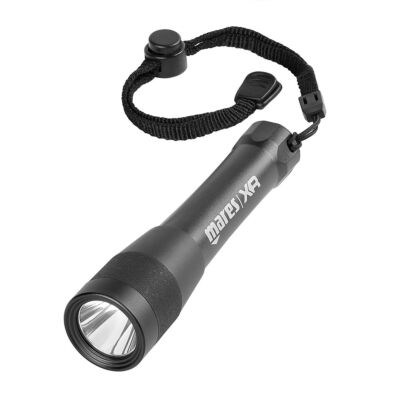Mares XR Back Up Light
- Twist-On activation, 850 raw Lumens, 12500 Lux at 1 meter
- Approximate 2.25 hour burn time with single 18650 Li-ion battery
- Approximate dimensions { 1.3 X 5.6 in | 34 X 142 mm}
- Dry weight { 5 oz | 140 gm} including battery
- IPX-8 waterproof to {330 ft | 100 m} depth
Mares XR Back Up Light
The Mares XR Back Up Light is a compact, low weight, handheld light featuring 12500 Lux at 1 meter with a very tight 8° beam angle suitable for technical diving applications. The light has an engineered thermoplastic body, aluminum head with twist-on activation and is IPX-8 rated waterproof to {330 ft | 100 m} depth. The LED outputs 850 raw lumens and measures 12500 Lux at 1 meter, with approximately 2.25 hour burn time on a single standard rechargeable 18650 Li-ion protected battery. The approximate dimensions are { 1.3 X 5.6 in | 34 X 142 mm} with a { 5 oz | 140 gm} dry weight including the battery.
In The Box: Package includes handheld light aluminum head and engineered thermoplastic body, 18650 battery and charger with USB cable, wrist lanyard, and spare gasket seal.
| Brand | Mares Extended Range |
|---|---|
| SKU | XR-415789 |
| Weight | 0.750000 |
Customer Reviews
Lumens, Lux, Burn Time and Kelvin - Caveat Emptor
Various LED dive light suppliers use different methods of determining light output, plus expressing them in different forms of measurement. What matters is the visible light from the LED that bounces off the reflector and passes through the lens. The quality of the reflector and lens, as well as the actual amount of power delivered by the battery have a major affect on the amount of light that reaches the target. Describing any LED dive light in terms of the specification of the entire output for a raw LED module without reflector and lens at maximum power under laboratory conditions is very misleading. Dive lights would be better described by the system lumens (sometimes called out-the-front or OTF lumens), which is the amount of visible light emitted by the entire system of housing, battery, electronics, diode, reflector and lens.
In our opinion, using lux measured at the target distance (typically 1 or 2 meters), and not just initially but graphed across the entire burn time, is the best way to describe the brightness of dive lights. The difference is that the lux takes into account the area over which the light beam is spread and thus the beam angle. The lux is the visible light measured at the target distance, not the bulb. A light of 1000 lumens, concentrated into an area of one square meter, is said to illuminate that square meter with an brightness of 1,000 lux. However, the same 1000 lumens, spread out over ten square meters, produces a much lower value of only 100 lux.
Some lights appear white or "cool" in color while others appear brownish or "warm" in color. The temperatures in °Kelvin used by manufacturers to precisely describe the color produced by their LED dive light may not be as accurate as you might expect. Dive light manufacturers typically just describe the color of their lights using the technical specification from the diode supplier. However, the actual OTF color can also be affected by the other components the manufacturer used to build the light. We found a helpful discussion with example photographs at Understanding Kelvin and LED Light Color Temperatures.
There is a test standard (ANSI/NEMA FL-1, approved in 2009) for measuring flashlight lumen output, burn time and impact resistance. Sadly, most dive light manufacturers do not rate their lights using the FL-1 standard. Until they do, we must rely upon our supplier internally published specifications for our descriptions, but we suggest you take all of them with a grain of salt. Like the fuel economy ratings on automobiles, your results for light output and burn times may vary considerably from the questionable values being published by the dive light manufacturers.




